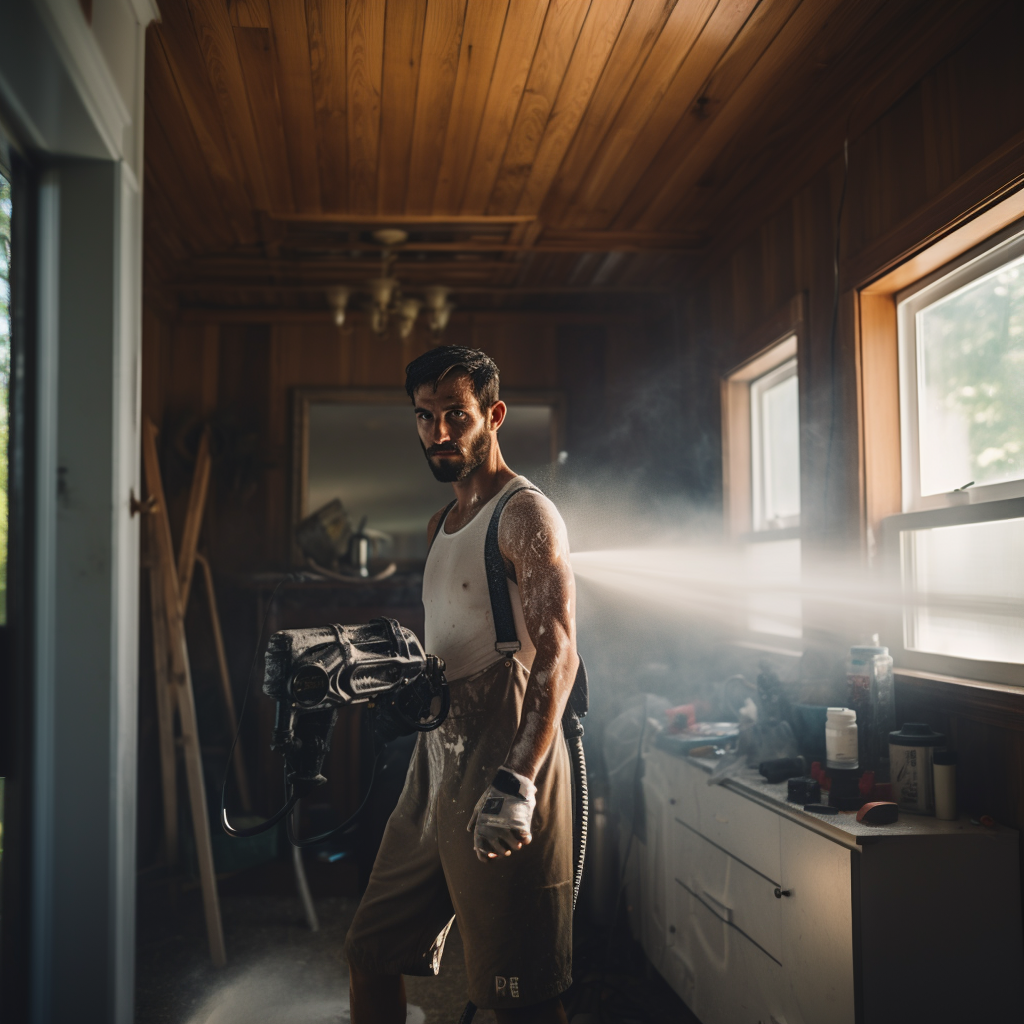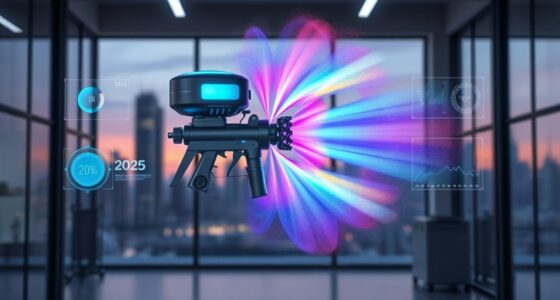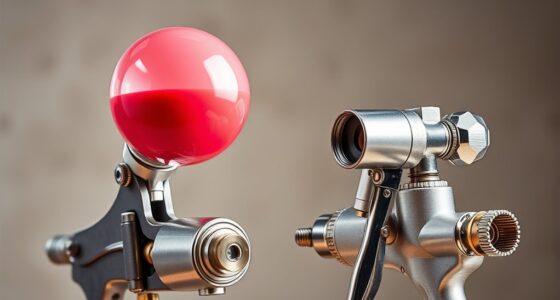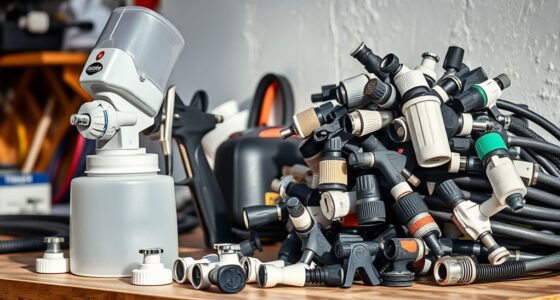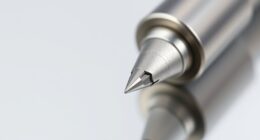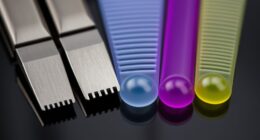Choosing the right paint sprayer nozzles and tips is essential for a professional finish. Larger nozzles cover big areas quickly, while smaller tips are perfect for detail work. Match your nozzle size and spray pattern to your project, paint type, and surface. Proper adjustments and maintenance guarantee smooth application and avoid common mistakes. If you want to learn more about selecting and caring for your spray tips, keep exploring these helpful tips.
Key Takeaways
- Nozzle size determines spray pattern width, suitable for large surfaces or fine detail work.
- Different tips (conventional, HVLP, airless) are designed for specific paint types and project needs.
- Match nozzle material and size to paint viscosity and project surface for optimal results.
- Proper adjustments and cleaning ensure consistent spray quality and prevent clogs.
- Selecting the right nozzle and tip enhances efficiency, coverage, and professional finish.
Understanding Nozzle Sizes and Their Applications
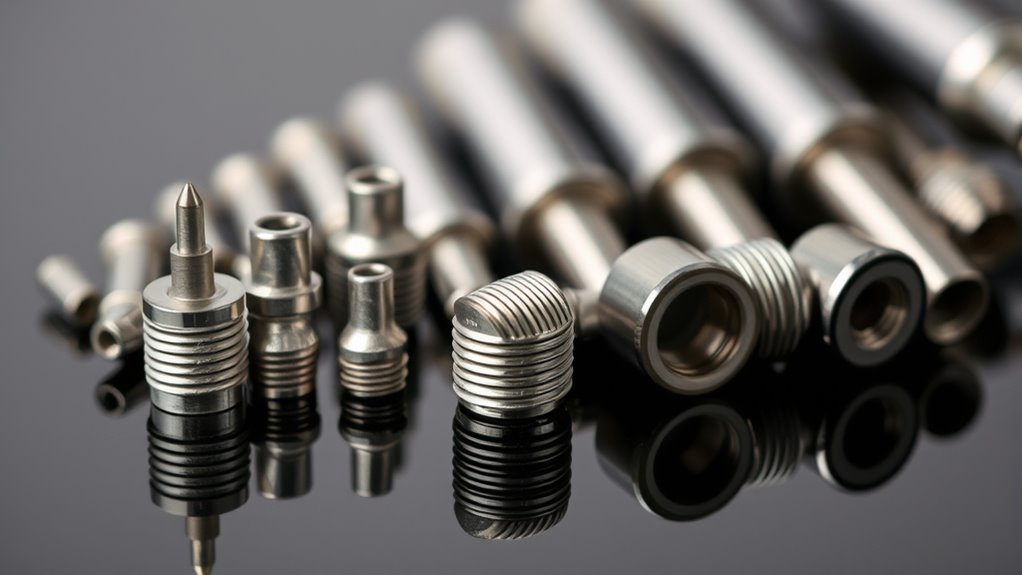
Have you ever wondered how different nozzle sizes affect your painting results? It all starts with nozzle manufacturing, which guarantees each size delivers a specific spray pattern. Larger nozzles produce wider sprays, ideal for covering large surfaces quickly, while smaller nozzles offer finer detail for precision work. Your choice also depends on paint viscosity; thicker paints require larger nozzles to prevent clogging, whereas thinner paints work well with smaller sizes. Understanding these factors helps you select the right nozzle for your project, making sure smooth application and professional results. Keep in mind that nozzle manufacturing quality impacts spray consistency, so choosing reputable brands makes a difference. By matching nozzle size to your paint’s viscosity and project needs, you’ll achieve perfect coverage and finish every time.
Types of Paint Sprayer Tips and Their Functions
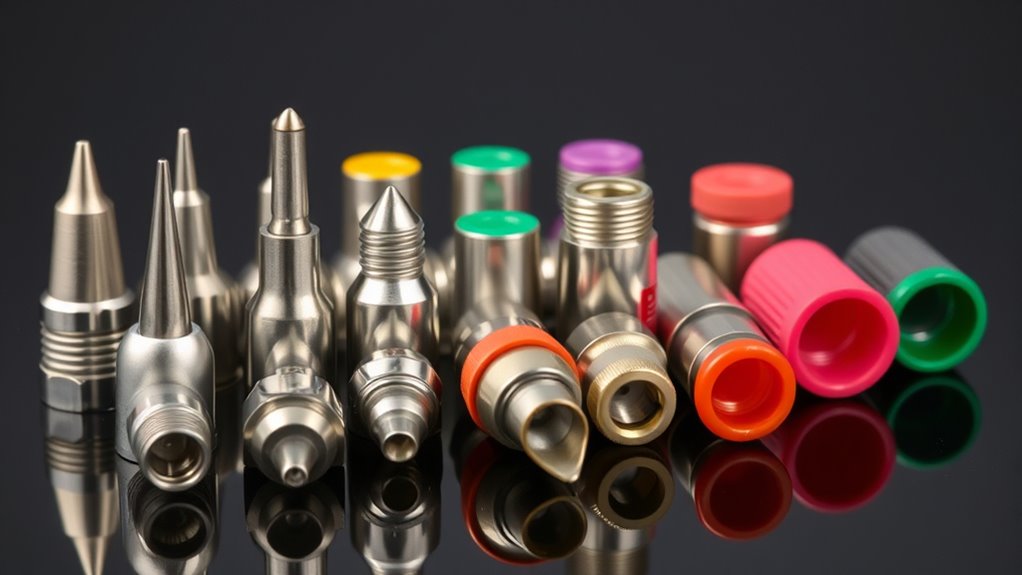
Different paint sprayer tips come in various types, each designed for specific spray patterns and finishes. You’ll find options that produce narrow or wide coverage, making them ideal for different projects. Understanding these variations helps you choose the right tip for your application area, whether it’s furniture, walls, or large surfaces. Selecting the appropriate tip size and type can also help minimize paint waste and ensure a smoother application. For example, choosing the correct tip size based on paint viscosity and project needs can improve efficiency and finish quality. Additionally, knowing how tuning can optimize equipment performance ensures consistent spray results and prolongs the lifespan of your sprayer. Proper cleaning and maintenance of tips also contribute to maintaining their accuracy and longevity over time.
Tip Types Overview
Wondering which paint sprayer tip best suits your project? Different tip types are designed for specific paint thicknesses and spray gun ergonomics, ensuring ideal results. For thicker paints, you’ll want a larger tip that allows better flow, while finer finishes require smaller tips. Here’s an overview:
| Tip Type | Best For | Key Benefit |
|---|---|---|
| Conventional | Thicker paints, furniture | Good coverage, durability |
| HVLP | Thin paints, detail work | Reduced overspray, control |
| Airless | Heavy-duty coating applications | Fast coverage, high pressure |
| Fine Finish | Lacquers, varnishes | Smooth, precise spray |
| Multi-purpose | Versatile projects | Balanced for various paints |
Choosing the right tip enhances spray gun ergonomics, providing ease of use and better control over paint thickness. Regular use of appropriate tips can also help in achieving consistent application, which is crucial for a professional-looking finish. Being aware of paint viscosity and how it interacts with different tips can further improve your results. Additionally, understanding spray pattern adjustments can help you fine-tune the application process for optimal coverage.
Spray Pattern Variations
Are you aware that the spray pattern of your paint sprayer considerably impacts the quality and efficiency of your project? Different spray patterns, such as round, fan, or vertical, influence how evenly the paint is applied and how well you achieve your desired finishing techniques. For example, a fan pattern offers broad coverage for large surfaces, while a round pattern is better for detailed work. Environmental factors like humidity or wind can also affect pattern consistency, so choosing the right tip helps control overspray and uneven coating. Understanding spray pattern variations allows you to select the appropriate nozzle for each task, ensuring smooth application and professional results. Optimizing your spray technique involves not just nozzle selection but also understanding how projector technology can help you better understand how to optimize your tools for various applications. Additionally, being aware of nozzle sizes enables you to tailor spray coverage and paint flow to specific project requirements, leading to more precise and efficient work. Recognizing the importance of consistent spray patterns can help prevent defects and achieve a flawless finish. Moreover, selecting the correct nozzle tips can significantly influence the overall quality of your painting project by ensuring the right spray pattern and coverage. Incorporating regular maintenance of your sprayer can also improve performance and extend the lifespan of your equipment.
Suitable Application Areas
Choosing the right paint sprayer tip is vital for achieving the best results in your project. Different tips are suited for specific application areas, ensuring smooth finishes and efficient work. For detailed work, such as furniture or trim, fine tips help you master brush techniques and achieve precise control. Larger tips are ideal for broad surfaces like walls or fences, where speed matters. If you’re blending colors or doing decorative finishes, select tips that support even spray patterns for seamless color mixing. Additionally, selecting tips that complement your dog’s coat type can enhance the quality of your paint job and reduce the need for touch-ups. Incorporating industry transformations such as AI automation can also optimize your spraying process, making it more efficient and consistent. As automation advances, integrating AI-driven tools can further refine your technique and outcome, especially by leveraging prophetic insights to anticipate potential issues and improve planning.
How to Choose the Right Nozzle for Different Projects

When choosing a nozzle, you need to consider the material you’ll be spraying to ensure compatibility and prevent clogs. You should also think about the spray pattern you need—whether broad coverage or detailed work—to select the right nozzle size. By matching both material and pattern to your project, you’ll get the best finish and efficiency. Additionally, reviewing performance metrics can help determine which nozzle will deliver the desired speed and quality for your specific application. Considering nozzle efficiency ratings is also important for optimizing your spraying process and achieving consistent results. For instance, understanding the AI Discoveries related to new materials and techniques can inform your choice of equipment for automotive paint projects, ensuring you select a nozzle that can handle the specific demands of your vehicle refinishing tasks.
Material Compatibility
Selecting the right nozzle for your project depends heavily on the material you’re spraying. You need to consider paint compatibility and solvent considerations to ensure a smooth finish and avoid damage. Using the wrong nozzle can cause uneven spray, clogs, or paint failure.
Keep these in mind:
- Ensure your nozzle is compatible with the type of paint or stain you’re using to prevent issues. Consult material compatibility guides to confirm optimal pairing.
- Check solvent compatibility to avoid corrosion or damage, especially with solvent-based paints.
- Match nozzle size to your material’s viscosity for efficient application and a professional look.
- When choosing a nozzle, consider the specific Vetted product features that suit your project needs, such as flow rate and spray pattern, for optimal results.
Choosing the correct nozzle isn’t just about size; it’s about understanding how your material interacts with your equipment. This careful selection helps you achieve flawless results and saves time and frustration.
Spray Pattern Needs
The spray pattern you choose plays a key role in achieving a smooth, even finish tailored to your project’s specific needs. For thicker paint viscosity, a wider spray pattern helps make certain of proper coverage without drips or uneven layers. Conversely, thinner paints benefit from a narrower pattern for more control. Consider your spray gun’s ergonomics as well — a pattern that’s too broad might cause fatigue or overspray, especially during extended use. Think about the surface area and detail level; large surfaces need a fan pattern for efficiency, while intricate areas require a focused, narrower spray. Matching your spray pattern to the paint’s viscosity and your spray gun’s ergonomics ensures better control, reduces waste, and delivers a professional-looking finish. Awareness of regional legal resources can also help in case you need professional assistance or guidance for complex projects.
Tips for Adjusting Nozzle Settings for Optimal Results

Adjusting your nozzle settings correctly is essential for achieving a smooth, even paint finish. Start with the spray gun ergonomics in mind—comfortable grip and steady hand help maintain consistent pressure. Adjust the paint viscosity to guarantee proper flow; too thick, and you’ll clog the nozzle, too thin, and drips occur. Fine-tune the spray pattern and fluid flow for your project’s needs. Remember these tips:
Master nozzle adjustments for a flawless, professional paint finish with steady grip and proper viscosity.
- Feel confident as you control the spray, knowing you’re optimizing performance.
- Experience the satisfaction of a flawless, professional-looking finish.
- Enjoy the process as you master your spray gun and achieve perfect results every time.
- Being aware of AI detection methods can help you understand how digital tools influence content quality and authenticity.
Common Mistakes When Using Spray Nozzles and How to Avoid Them
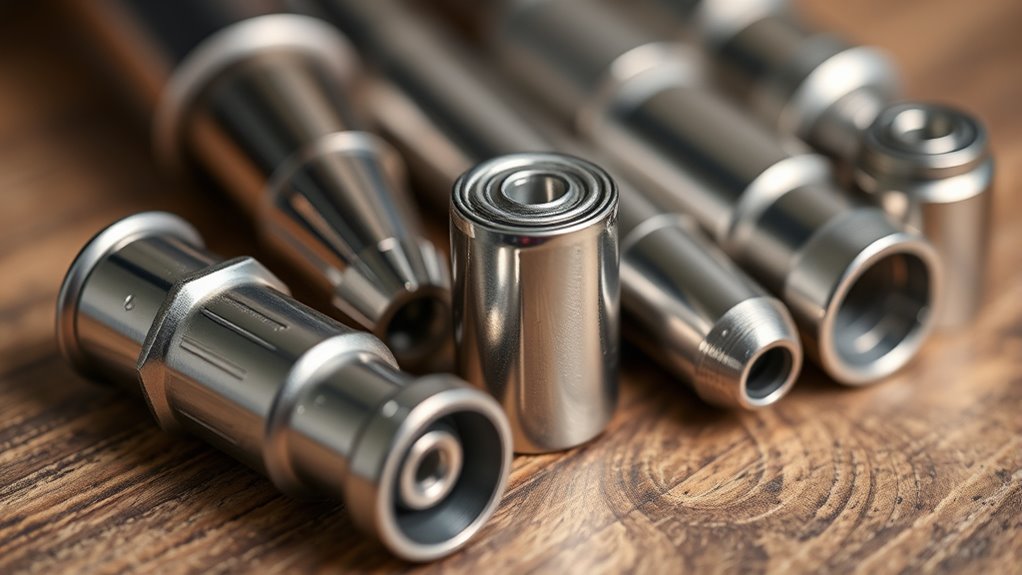
One common mistake is using the wrong nozzle size for the project, which can lead to uneven coverage or excessive overspray. Another frequent user error is neglecting proper cleaning, causing clogs and inconsistent spray patterns. To avoid these issues, always select the right nozzle for your task and clean it thoroughly after each use. Here’s a quick guide:
| Nozzle Size | Ideal Use | Common Error |
|---|---|---|
| 1.2mm | Fine furniture, touch-ups | Using for large surface areas |
| 2.0mm | Walls, fences | Using a small nozzle for big jobs |
| 3.0mm | Heavy coatings | Using a large nozzle for detail work |
Proper cleaning prevents buildup, ensuring consistent results and extending nozzle life.
Maintenance and Care for Your Spray Nozzles and Tips

Regular maintenance is essential to keep your spray nozzles and tips performing at their best. Proper cleaning procedures prevent clogs and guarantee a smooth spray pattern, saving you time and frustration. After each use, thoroughly clean your nozzles with the appropriate cleaning agents to remove paint residue and debris. Storage tips are also vital—completely dry your tips before storing them in a clean, dry container to prevent corrosion. Handle your nozzles with care to avoid damage, and avoid leaving paint in the tips overnight. By taking these simple steps, you’ll extend the lifespan of your spray equipment and assure consistent results.
Consistent cleaning and proper storage extend spray nozzle lifespan and ensure flawless finishes.
- Feel confident knowing your tools stay in top shape
- Experience flawless finishes every time
- Save money by avoiding replacements
Troubleshooting Spray Pattern Issues and Improving Performance

When you notice uneven spray patterns or inconsistent coverage, it’s a clear sign your spray equipment needs troubleshooting. Poor performance can cause visible brush strokes and uneven color mixing. First, check for clogs or dried paint in the nozzle, clean it thoroughly, and ensure proper nozzle size. Adjust spray pressure and distance to improve the pattern. Use this troubleshooting guide:
| Issue | Solution | Result |
|---|---|---|
| Uneven spray pattern | Clean nozzle, adjust pressure | Smooth, even coverage |
| Inconsistent spray flow | Check for clogs or leaks | Consistent paint flow |
| Brush strokes or dry spots | Adjust spray distance or technique | Better color blending |
Addressing these factors helps optimize performance and achieve a flawless finish.
Frequently Asked Questions
Can Nozzle Sizes Be Customized for Specific Projects?
Yes, you can customize nozzle sizes for your projects. Custom nozzle sizes allow you to tailor the spray pattern and flow rate to suit specific needs, ensuring a smooth, even finish. For complex or unique projects, you might opt for project-specific nozzles that provide better control and efficiency. Just make sure to choose the right size based on your material, surface, and desired outcome for supreme results.
How Long Do Spray Nozzles Typically Last?
You might wonder how long spray nozzles last; it depends on your nozzle maintenance and usage. Generally, a nozzle can last several hundred spray hours if you clean it regularly and avoid clogs. Proper maintenance guarantees consistent spray pattern accuracy and extends the nozzle’s lifespan. Keep an eye out for signs of wear or clogs, and replace the nozzle when spray pattern accuracy declines to ensure smooth, professional results.
Are There Eco-Friendly Options for Spray Tips?
Imagine spraying a fresh coat of paint, feeling good about protecting the environment. Yes, eco-friendly options exist for spray tips, made from biodegradable materials and designed with environmentally friendly coatings. These tips reduce plastic waste and chemical runoff, helping you paint responsibly. By choosing such options, you turn your project into a sustainable act, ensuring your work benefits both your space and the planet.
How Does Temperature Affect Nozzle Performance?
Temperature impacts nozzle performance mainly through thermal expansion and viscosity effects. As temperature rises, materials expand slightly, which can alter the nozzle’s size and spray pattern. Higher temperatures reduce the paint’s viscosity, allowing for smoother flow and finer mist. Conversely, cold temperatures increase viscosity, making spraying harder and potentially causing clogs. You should adjust your sprayer settings based on temperature changes to guarantee consistent, quality results.
Can Nozzles Be Used With Different Types of Paints?
While it’s tempting to think nozzles can handle every type of paint, you should consider paint compatibility for ideal results. Using the right nozzle for different paints ensures smooth application and prevents clogging. Remember, nozzle cleaning is key when switching between paints to avoid residuals that could affect finish and performance. Always check manufacturer guidelines to match nozzles with specific paint types, making your work easier and more effective.
Conclusion
Choosing the right spray nozzle is like selecting the perfect brush for a masterpiece—you’re in control of the outcome. By understanding sizes, tips, and adjustments, you’ll turn your projects into smooth, professional finishes. Keep your nozzles clean and pay attention to your spray patterns, and you’ll avoid common pitfalls. With a little care and practice, your sprayer will become an extension of your creativity, transforming surfaces with the precision of an artist’s hand.
Franz came aboard the Paint Sprayer Zone team with a background in both journalism and home renovation. His articulate writing style, combined with a passion for DIY projects, makes him an invaluable asset. Franz has a knack for breaking down technical jargon into easy-to-understand content, ensuring that even the most novice of readers can grasp the complexities of paint sprayers.


